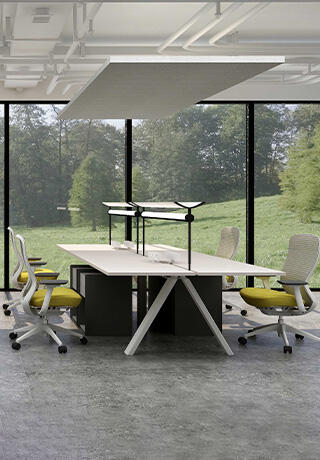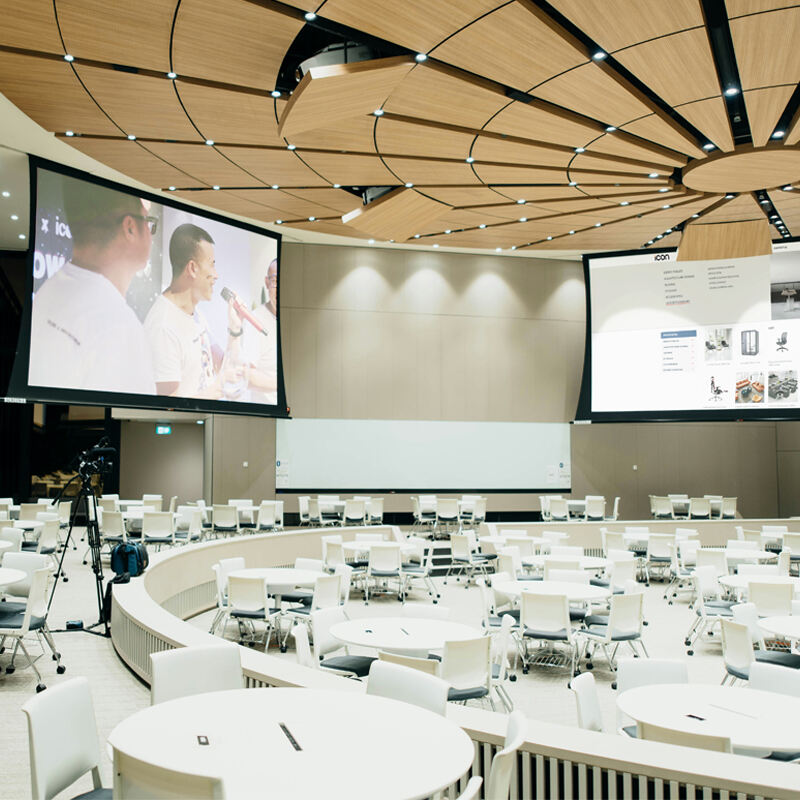Pagbabago Workstation Kahusayan sa Pamamagitan ng Organisadong Mga Solusyon sa Kable
Sa mga lugar ng trabaho ngayon na pinapatakbo ng teknolohiya, ang kahalagahan ng pamamahala sa kable ay umunlad mula sa simpleng pagpipilian sa estetika tungo sa mahalagang aspeto ng pag-andar ng workspace. Ang mga modernong workstations nakatira karaniwang maraming device, mula sa mga kompyuter at monitor hanggang sa telepono at iba't ibang peripheral, na bawat isa ay nangangailangan ng power at data connection. Ang resultang hugpong ng mga kable ay maaaring palakasin o hadlangan ang produktibidad, depende sa kung gaano kahusay ang pagkakaayos nito.
Mahalaga ang pamamahala ng kable sa paglikha ng isang mahusay, ligtas, at propesyonal na kapaligiran sa trabaho. Higit pa sa mga halatang benepisyo sa estetika, nakakaapekto ang tamang pagkakaayos ng kable sa lahat mula sa produktibidad ng mga empleyado hanggang sa kaligtasan sa workplace at haba ng buhay ng kagamitan. Habang lumalaki ang kumplikado ng mga work station dahil sa patuloy na pag-unlad ng teknolohiya, lalong tumitindi ang pangangailangan para sa epektibong solusyon sa pamamahala ng kable.
Ang Epekto ng Pamamahala ng Kable sa Produktibidad sa Trabaho
Na-optimize na Workflow at Accessibility
Kapag maayos ang pagkakaayos ng mga kable, mas kaunti ang oras na ginugugol ng mga empleyado sa pagharap sa mga nakakalito at nakadarambing kable at mas maraming oras ang mailalaan nila sa kanilang gawain. Pinapadali ng maayos na sistema ng pamamahala ng kable ang mabilisang pag-access sa mga port at koneksyon, na nagbibigay-daan para madaling ikonekta o ikubli ang mga device kung kinakailangan. Ang ganitong kahusayan ay lalo pang nagiging mahalaga sa mga dinamikong kapaligiran sa trabaho kung saan kailangang madalas ilipat o i-reconfigure ang mga kagamitan.
Bukod dito, ang maayos na pagkakaayos ng mga kable ay nakatutulong sa mas malinis na ibabaw ng mesa, na nagbibigay ng higit na magagamit na espasyo para sa trabaho. Ang karagdagang espasyong ito ay maaaring makabuluhang mapabuti ang kahusayan ng daloy ng gawain at mabawasan ang mental na kalat na kadalasang kasama ng pisikal na kaguluhan. Ipinapakita ng mga pag-aaral na ang maayos na lugar ng trabaho ay maaaring dagdagan ang produktibidad ng hanggang 15%, at ang pamamahala ng kable ay isang mahalagang bahagi ng ganitong pagkakaayos.
Pinaunlad na Kaligtasan at Pagbawas ng Panganib
Ang tamang pamamahala ng mga kable ay malaki ang nakikitulong sa pagbawas ng mga panganib sa lugar ng trabaho. Ang mga nakalas na kable ay nagdudulot ng panganib na madapa at maaaring magdulot ng aksidente na may kasamang sugat o nasirang kagamitan. Sa pamamagitan ng epektibong mga solusyon sa pamamahala ng kable, ang mga organisasyon ay maaaring bawasan ang mga panganib na ito habang pinoprotektahan nang sabay ang mga mahahalagang teknolohikal na pamumuhunan.
Ang pagbawas sa mga aksidente sa lugar ng trabaho ay hindi lamang nagagarantiya sa kaligtasan ng mga empleyado kundi nakatutulong din sa mga kumpanya na maiwasan ang potensyal na mga isyu sa pananagutan at mapanatili ang pagsunod sa mga regulasyon sa kaligtasan sa trabaho. Bukod dito, ang maayos na mga kable ay mas hindi madaling mahila o masira nang hindi sinasadya, na nagpapahaba sa buhay ng mga kable at ng mga konektadong device.
Mga Modernong Solusyon at Teknolohiya para sa Pamamahala ng Kable
Mga Inobatibong Solusyon sa Hardware
Ang kasalukuyang merkado ay nag-aalok ng malawak na hanay ng mga hardware para sa pamamahala ng kable na idinisenyo upang tugunan ang iba't ibang pangangailangan sa lugar ng trabaho. Ang mga cable tray, raceway, at mga sistema ng pamamahala ng kable sa ilalim ng desk ay nagbibigay ng istrukturang landas para sa tamang ruta ng mga kable habang ito ay nakatago sa paningin. Ang modular na mga solusyon ay nagbibigay-daan sa madaling pagbabago habang umuunlad ang pangangailangan sa lugar ng trabaho, samantalang unti-unti nang binabawasan ng mga teknolohiyang wireless charging ang kabuuang dami ng mga kable.
Ang mga advanced na sistema sa pamamahala ng kable ay kasalukuyang may mga tampok tulad ng built-in na power distribution units, na nagagarantiya ng maayos na organisasyon at komportableng pag-access sa mga pinagkukunan ng kuryente. Kasama sa mga solusyong ito ang mga probisyon para sa hinaharap na pagpapalawak, na ginagawa itong mahalagang pangmatagalang imbestimento para sa mga umuunlad na organisasyon.
Pagsasama ng Software at Matalinong Sistema
Ang hinaharap ng pamamahala ng kable ay lampas sa pisikal na organisasyon, kung saan kasama na ang mga matalinong sistema na kayang magbantay at mamahala ng distribusyon ng kuryente. Ang mga sistemang ito ay kayang subaybayan ang paggamit ng kuryente, matukoy ang potensyal na problema bago pa man ito lumala, at kusa pang i-adjust ang distribusyon ng kuryente batay sa mga pattern ng paggamit.
Ang pagsasama sa software ng pamamahala sa workplace ay nagbibigay-daan sa mga organisasyon na mapanatili ang detalyadong dokumentasyon ng kanilang imprastruktura ng kable, na nagpapasimple sa pagpapanatili at pag-upgrade. Ang digital na paraan ng pamamahala ng kable ay naging mas mahalaga habang ang mga workplace ay nagiging mas sopistikado sa teknolohiya.

Mga Konsiderasyon sa Disenyo para sa Optimal na Pamamahala ng Kable
Pang-ergonomikong Implementasyon
Dapat isaalang-alang ang mga prinsipyo ng ergonomiks sa epektibong pamamahala ng kable upang matiyak na hindi makakaapiw ang mga solusyon sa ginhawa at paggalaw ng mga empleyado. Kasama rito ang pagsiguro na ang mga kable ay nakapaloob sa mga lugar kung saan hindi ito maaaring mahawakan ng mga gumagamit, at ang mga punto ng koneksyon na madalas gamitin ay madaling maabot nang walang di-komportableng posisyon.
Ang paglalagay ng mga saksakan ng kuryente, mga landas ng pamamahala ng kable, at mga punto ng access ay dapat maplanong may pag-iisip sa ugali ng gumagamit. Ang ganitong paraan na nakatuon sa tao sa disenyo ng pamamahala ng kable ay tumutulong na mapanatili ang kahusayan sa lugar ng trabaho habang pinananatili ang kalusugan at kagalingan ng mga empleyado.
Pagsasamahang Estetiko
Ang modernong disenyo ng estasyon ng trabaho ay patuloy na binibigyang-diin ang pangkatauhan ng mga solusyon sa pamamahala ng kable. Ang malinis na linya at nakatagong mga landas ng kable ay nag-aambag sa isang propesyonal na hitsura na maaaring makaapekto sa impresyon ng kliyente at espiritu ng mga empleyado. Maraming makabagong sistema ng pamamahala ng kable ang dinisenyo upang makisabay sa modernong estetika ng opisina habang pinapanatili ang buong kakayahang gumana.
Ang pagsasama ng pamamahala ng kable sa disenyo ng muwebles ay nagdulot ng mga inobatibong solusyon tulad ng mga nakapaloob na channel at mga opsyon para sa nakatagong routing. Ang mga tampok na ito ay nagbibigay-daan sa mga estasyon ng trabaho na mapanatili ang isang manipis, propesyonal na hitsura nang hindi kinukompromiso ang konektibidad o pagkakabukas.
Pangangalaga at Pagsisiguro sa Kinabukasan
Regularyong mga Praktika sa Paggamit
Kailangan ng regular na atensyon at mga update upang mapanatili ang isang maayos na sistema ng pamamahala ng kable. Kasama rito ang panreglamento ng pagsuri sa mga nasirang kable, pagtiyak na nananatiling buo ang tamang paglalabel, at pagbabago sa routing ng kable kung kinakailangan. Mas madaling i-troubleshoot at baguhin ang isang maayos na pinapanatilihing sistema kapag kinakailangan.
Dapat magtatag ang mga organisasyon ng mga regular na iskedyul ng pagpapanatili at mga prosedurang dokumentasyon upang matiyak na patuloy na gumagana nang epektibo ang kanilang mga sistema ng pamamahala ng kable. Tinitiyak ng proaktibong pamamaraang ito na maiiwasan ang mga isyu bago pa man ito lumitaw at mapapalawig ang buhay ng sistema ng pamamahala at ng mismong mga kable.
Pagbabago para sa Mga Hinaharap na Teknolohiya
Kapag ipinatutupad ang mga solusyon sa pamamahala ng kable, mahalaga na isaalang-alang ang hinaharap na mga pag-unlad sa teknolohiya at potensyal na mga pagbabago sa lugar ng trabaho. Ang mga fleksibleng sistema na kayang umangkop sa bagong uri ng mga kable at nagbabagong pangangailangan sa konektibidad ay magbibigay ng mas mahusay na halaga sa mahabang panahon kumpara sa matitigas at limitadong solusyon.
Ang uso patungo sa wireless na teknolohiya at alternatibong paraan ng paghahatid ng kuryente ay maaaring bawasan ang ilang pangangailangan sa pamamahala ng kable sa hinaharap, ngunit hindi malamang na ganap itong mapapawi. Ang pagpaplano para sa kasalukuyan at hinaharap na pangangailangan ay nagsisiguro na mananatiling may halaga ang mga pamumuhunan sa pamamahala ng kable habang umuunlad ang teknolohiya.
Mga madalas itanong
Paano nakakaapekto ang pamamahala ng kable sa haba ng buhay ng kagamitan?
Ang maayos na pamamahala ng kable ay nakakatulong upang maiwasan ang pagtensiyon, pagkakabilo, at pisikal na pinsala sa kable, na maaaring makapagpahaba nang malaki sa buhay ng parehong kable at ng mga konektadong kagamitan. Pinabubuti rin nito ang daloy ng hangin sa paligid ng mga device, na binabawasan ang panganib ng sobrang pag-init at kaugnay na mga isyu sa pagganap.
Ano ang mga pangunahing bahagi ng isang epektibong sistema ng pamamahala ng kable?
Ang isang epektibong sistema ng pamamahala ng kable ay karaniwang kasama ang mga tray o raceway para sa kable, mga tali o strap para sa kable, tamang paglalagay ng label, sapat na pamamahala ng kaluwagan ng kable, at angkop na landas ng routing. Dapat din itong magkaroon ng madaling puntong pang-access para sa pagpapanatili at pagbabago habang nananatiling malinis ang itsura.
Gaano kadalas dapat suriin at i-update ang mga sistema ng pamamahala ng kable?
Dapat suriin ang mga sistema ng pamamahala ng kable bawat trimestre para sa pangunahing pagpapanatili at taun-taon para sa mas malawakang pagsusuri. Maaaring kailanganin ang mga update kapag nagdagdag ng bagong kagamitan, inilipat ang mga estasyon sa trabaho, o ipinatupad ang mga bagong teknolohiya. Ang regular na pagsusuri ay nakakatulong upang mapanatili ang kahusayan ng sistema at maiwasan ang mga potensyal na problema.
Talaan ng mga Nilalaman
- Pagbabago Workstation Kahusayan sa Pamamagitan ng Organisadong Mga Solusyon sa Kable
- Ang Epekto ng Pamamahala ng Kable sa Produktibidad sa Trabaho
- Mga Modernong Solusyon at Teknolohiya para sa Pamamahala ng Kable
- Mga Konsiderasyon sa Disenyo para sa Optimal na Pamamahala ng Kable
- Pangangalaga at Pagsisiguro sa Kinabukasan
- Mga madalas itanong





